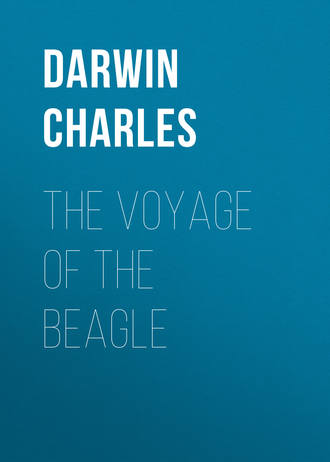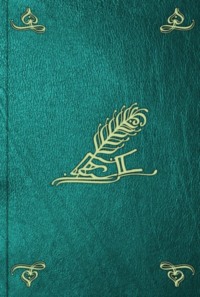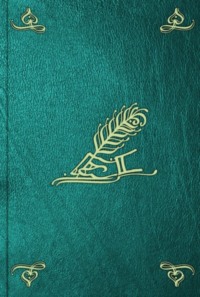 полная версия
полная версияThe Voyage of the Beagle
142
Dr. Gillies in Journ. of Nat. and Geograph. Science, Aug., 1830. This author gives the heights of the Passes.
143
This structure in frozen snow was long since observed by Scoresby in the icebergs near Spitzbergen, and, lately, with more care, by Colonel Jackson (Journ. of Geograph. Soc., vol. v. p. 12) on the Neva. Mr. Lyell (Principles, vol. iv. p. 360) has compared the fissures by which the columnar structure seems to be determined, to the joints that traverse nearly all rocks, but which are best seen in the non-stratified masses. I may observe, that in the case of the frozen snow, the columnar structure must be owing to a "metamorphic" action, and not to a process during deposition.
144
This is merely an illustration of the admirable laws, first laid down by Mr. Lyell, on the geographical distribution of animals, as influenced by geological changes. The whole reasoning, of course, is founded on the assumption of the immutability of species; otherwise the difference in the species in the two regions might be considered as superinduced during a length of time.
145
Vol. iv. p. 11, and vol. ii. p. 217. For the remarks on Guayaquil, see Silliman's Journ., vol. xxiv. p. 384. For those on Tacna by Mr. Hamilton, see Trans. of British Association, 1840. For those on Coseguina see Mr. Caldcleugh in Phil. Trans., 1835. In the former edition I collected several references on the coincidences between sudden falls in the barometer and earthquakes; and between earthquakes and meteors.
146
Observa. sobre el Clima de Lima, p. 67. – Azara's Travels, vol. i. p. 381. – Ulloa's Voyage, vol. ii. p. 28. – Burchell's Travels, vol. ii. p. 524. – Webster's Description of the Azores, p. 124. – Voyage a l'Isle de France par un Officer du Roi, tom. i. p. 248. – Description of St. Helena, p. 123.
147
Temple, in his travels through Upper Peru, or Bolivia, in going from Potosi to Oruro, says, "I saw many Indian villages or dwellings in ruins, up even to the very tops of the mountains, attesting a former population where now all is desolate." He makes similar remarks in another place; but I cannot tell whether this desolation has been caused by a want of population, or by an altered condition of the land.
148
Edinburgh, Phil. Journ., Jan., 1830, p. 74; and April, 1830, p. 258 – also Daubeny on Volcanoes, p. 438; and Bengal Journ., vol. vii. p. 324.
149
Political Essay on the Kingdom of New Spain, vol. iv. p. 199.
150
A similar interesting case is recorded in the Madras Medical Quart. Journ., 1839, p. 340. Dr. Ferguson, in his admirable Paper (see 9th vol. of Edinburgh Royal Trans.), shows clearly that the poison is generated in the drying process; and hence that dry hot countries are often the most unhealthy.
151
The progress of research has shown that some of these birds, which were then thought to be confined to the islands, occur on the American continent. The eminent ornithologist, Mr. Sclater, informs me that this is the case with the Strix punctatissima and Pyrocephalus nanus; and probably with the Otus Galapagoensis and Zenaida Galapagoensis: so that the number of endemic birds is reduced to twenty-three, or probably to twenty-one. Mr. Sclater thinks that one or two of these endemic forms should be ranked rather as varieties than species, which always seemed to me probable.
152
This is stated by Dr. Gunther (Zoolog. Soc. Jan 24th, 1859) to be a peculiar species, not known to inhabit any other country.
153
Voyage aux Quatre Iles d'Afrique. With respect to the Sandwich Islands, see Tyerman and Bennett's Journal, vol. i. p. 434. For Mauritius, see Voyage par un Officier, etc., part i. p. 170. There are no frogs in the Canary Islands (Webb et Berthelot, Hist. Nat. des Iles Canaries). I saw none at St. Jago in the Cape de Verds. There are none at St. Helena.
154
Ann. and Mag. of Nat. Hist., vol. xvi. p. 19.
155
Voyage in the U. S. ship Essex, vol. i. p. 215.
156
Linn. Trans., vol. xii. p. 496. The most anomalous fact on this subject which I have met with is the wildness of the small birds in the Arctic parts of North America (as described by Richardson, Fauna Bor., vol. ii. p. 332), where they are said never to be persecuted. This case is the more strange, because it is asserted that some of the same species in their winter-quarters in the United States are tame. There is much, as Dr. Richardson well remarks, utterly inexplicable connected with the different degrees of shyness and care with which birds conceal their nests. How strange it is that the English wood-pigeon, generally so wild a bird, should very frequently rear its young in shrubberies close to houses!
157
It is remarkable how the same disease is modified in different climates. At the little island of St. Helena the introduction of scarlet fever is dreaded as a plague. In some countries, foreigners and natives are as differently affected by certain contagious disorders as if they had been different animals; of which fact some instances have occurred in Chile; and, according to Humboldt, in Mexico (Polit. Essay, New Spain, vol. iv.).
158
Narrative of Missionary Enterprise, p. 282.
159
Captain Beechey (chap. iv., vol. i.) states that the inhabitants of Pitcairn Island are firmly convinced that after the arrival of every ship they suffer cutaneous and other disorders. Captain Beechey attributes this to the change of diet during the time of the visit. Dr. Macculloch (Western Isles, vol. ii. p. 32) says: "It is asserted, that on the arrival of a stranger (at St. Kilda) all the inhabitants, in the common phraseology, catch a cold." Dr. Macculloch considers the whole case, although often previously affirmed, as ludicrous. He adds, however, that "the question was put by us to the inhabitants who unanimously agreed in the story." In Vancouver's Voyage, there is a somewhat similar statement with respect to Otaheite. Dr. Dieffenbach, in a note to his translation of the Journal, states that the same fact is universally believed by the inhabitants of the Chatham Islands, and in parts of New Zealand. It is impossible that such a belief should have become universal in the northern hemisphere, at the Antipodes, and in the Pacific, without some good foundation. Humboldt (Polit. Essay on King of New Spain, vol. iv.) says, that the great epidemics of Panama and Callao are "marked" by the arrival of ships from Chile, because the people from that temperate region, first experience the fatal effects of the torrid zones. I may add, that I have heard it stated in Shropshire, that sheep, which have been imported from vessels, although themselves in a healthy condition, if placed in the same fold with others, frequently produce sickness in the flock.
160
Travels in Australia, vol. i. p. 154. I must express my obligation to Sir T. Mitchell, for several interesting personal communications on the subject of these great valleys of New South Wales.
161
I was interested by finding here the hollow conical pitfall of the lion-ant, or some other insect; first a fly fell down the treacherous slope and immediately disappeared; then came a large but unwary ant; its struggles to escape being very violent, those curious little jets of sand, described by Kirby and Spence (Entomol., vol. i. p. 425) as being flirted by the insect's tail, were promptly directed against the expected victim. But the ant enjoyed a better fate than the fly, and escaped the fatal jaws which lay concealed at the base of the conical hollow. This Australian pitfall was only about half the size of that made by the European lion-ant.
162
Physical Description of New South Wales and Van Diemen's Land, p. 354.
163
These Plants are described in the Annals of Nat. Hist., vol. i., 1838, p. 337.
164
Holman's Travels, vol. iv. p. 378.
165
Kotzebue's First Voyage, vol. iii. p. 155.
166
The thirteen species belong to the following orders: – In the Coleoptera, a minute Elater; Orthoptera, a Gryllus and a Blatta; Hemiptera, one species; Homoptera, two; Neuroptera a Chrysopa; Hymenoptera, two ants; Lepidoptera nocturna, a Diopaea, and a Pterophorus (?); Diptera, two species.
167
Kotzebue's First Voyage, vol. iii. p. 222.
168
The large claws or pincers of some of these crabs are most beautifully adapted, when drawn back, to form an operculum to the shell, nearly as perfect as the proper one originally belonging to the molluscous animal. I was assured, and as far as my observations went I found it so, that certain species of the hermit-crab always use certain species of shells.
169
Some natives carried by Kotzebue to Kamtschatka collected stones to take back to their country.
170
See Proceedings of Zoological Society, 1832, p. 17.
171
Tyerman and Bennett. Voyage, etc. vol. ii. p. 33.
172
I exclude, of course, some soil which has been imported here in vessels from Malacca and Java, and likewise, some small fragments of pumice, drifted here by the waves. The one block of greenstone, moreover, on the northern island must be excepted.
173
These were first read before the Geological Society in May, 1837, and have since been developed in a separate volume on the "Structure and Distribution of Coral Reefs."
174
It is remarkable that Mr. Lyell, even in the first edition of his "Principles of Geology," inferred that the amount of subsidence in the Pacific must have exceeded that of elevation, from the area of land being very small relatively to the agents there tending to form it, namely, the growth of coral and volcanic action.
175
It has been highly satisfactory to me to find the following passage in a pamphlet by Mr. Couthouy, one of the naturalists in the great Antarctic Expedition of the United States: – "Having personally examined a large number of coral-islands and resided eight months among the volcanic class having shore and partially encircling reefs. I may be permitted to state that my own observations have impressed a conviction of the correctness of the theory of Mr. Darwin." – The naturalists, however, of this expedition differ with me on some points respecting coral formations.
176
After the volumes of eloquence which have poured forth on this subject, it is dangerous even to mention the tomb. A modern traveller, in twelve lines, burdens the poor little island with the following titles, – it is a grave, tomb, pyramid, cemetery, sepulchre, catacomb, sarcophagus, minaret, and mausoleum!
177
It deserves notice, that all the many specimens of this shell found by me in one spot, differ as a marked variety, from another set of specimens procured from a different spot.
178
Beatson's St. Helena. Introductory chapter, p. 4.
179
Among these few insects, I was surprised to find a small Aphodius (nov. spec.) and an Oryctes, both extremely numerous under dung. When the island was discovered it certainly possessed no quadruped, excepting perhaps a mouse: it becomes, therefore, a difficult point to ascertain, whether these stercovorous insects have since been imported by accident, or if aborigines, on what food they formerly subsisted. On the banks of the Plata, where, from the vast number of cattle and horses, the fine plains of turf are richly manured, it is vain to seek the many kinds of dung-feeding beetles, which occur so abundantly in Europe. I observed only an Oryctes (the insects of this genus in Europe generally feed on decayed vegetable matter) and two species of Phanaeus, common in such situations. On the opposite side of the Cordillera in Chiloe, another species of Phanaeus is exceedingly abundant, and it buries the dung of the cattle in large earthen balls beneath the ground. There is reason to believe that the genus Phanaeus, before the introduction of cattle, acted as scavengers to man. In Europe, beetles, which find support in the matter which has already contributed towards the life of other and larger animals, are so numerous that there must be considerably more than one hundred different species. Considering this, and observing what a quantity of food of this kind is lost on the plains of La Plata, I imagined I saw an instance where man had disturbed that chain, by which so many animals are linked together in their native country. In Van Diemen's Land, however, I found four species of Onthophagus, two of Aphodius, and one of a third genus, very abundantly under the dung of cows; yet these latter animals had been then introduced only thirty-three years. Previous to that time the kangaroo and some other small animals were the only quadrupeds; and their dung is of a very different quality from that of their successors introduced by man. In England the greater number of stercovorous beetles are confined in their appetites; that is, they do not depend indifferently on any quadruped for the means of subsistence. The change, therefore, in habits which must have taken place in Van Diemen's Land is highly remarkable. I am indebted to the Rev. F. W. Hope, who, I hope, will permit me to call him my master in Entomology, for giving me the names of the foregoing insects.
180
Monats. der Konig. Akad. d. Wiss. zu Berlin. Vom April, 1845.
181
I have described this Bar in detail, in the Lond. and Edin. Phil. Mag., vol. xix. (1841), p. 257.









